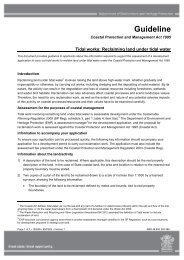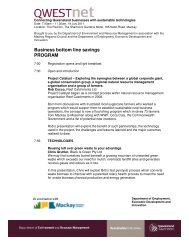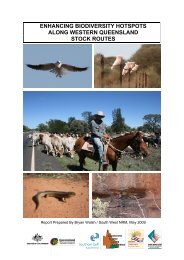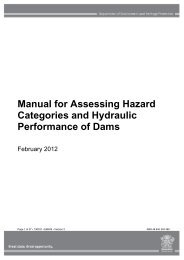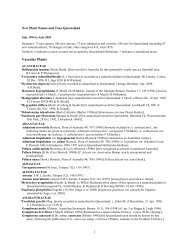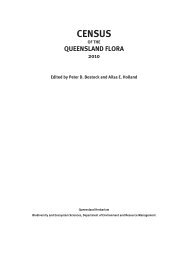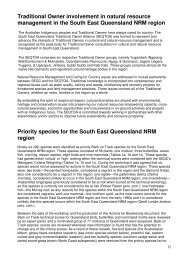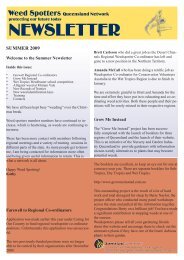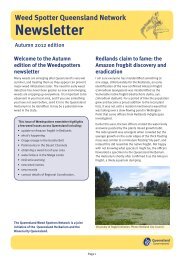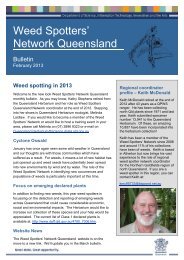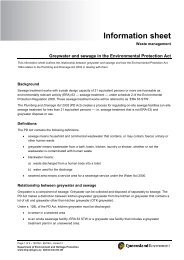WATERANGA PROJECT - Department of Environment and Heritage ...
WATERANGA PROJECT - Department of Environment and Heritage ...
WATERANGA PROJECT - Department of Environment and Heritage ...
You also want an ePaper? Increase the reach of your titles
YUMPU automatically turns print PDFs into web optimized ePapers that Google loves.
Wateranga Project<br />
Queensl<strong>and</strong> Industrial Minerals Ltd Initial Advice Statement<br />
result <strong>of</strong> the actual recoveries <strong>of</strong> the minerals to date, appear to be well in excess <strong>of</strong><br />
QIMs expectations.<br />
QIM is currently in negotiations with a major international engineering <strong>and</strong><br />
construction company in respect <strong>of</strong> all aspects <strong>of</strong> the mine’s technical <strong>and</strong> logistic<br />
requirements.<br />
5.3.4. Water Management <strong>and</strong> Supply<br />
The primary water requirement for the Wateranga Project will be for the gravity<br />
separation component <strong>of</strong> the mineral processing plant. Based on laboratory tests <strong>of</strong><br />
the drill samples extracted by QIM, estimates indicate that approximately 700 – 1,000<br />
litres <strong>of</strong> water will be required to process one tonne <strong>of</strong> ore. This will equate to a total<br />
water consumption requirement <strong>of</strong> approximately 1,575 - 2,250 mega litres per<br />
annum, assuming 50% return from tails water. For the operation, QIM will, as much<br />
as possible, use recycled water including the utilisation from water collection points<br />
within the MLA.<br />
Water will also be required for dust suppression, domestic use <strong>and</strong> re-vegetation<br />
operations. These activities only have minor water requirements in comparison to<br />
the processing plant requirements. Total water usage for the secondary activities is<br />
not expected to exceed 150 mega litres per annum. Therefore the estimated annual<br />
water requirement for Central MLA (at 2.4 mega tonnes per annum) is approximately<br />
2400 mega litres.<br />
The water requirements for the Wateranga Project are expected to be met <strong>and</strong><br />
supplied from the following sources:<br />
Use <strong>of</strong> existing water licences within the area (to be used before the Burnett Dam<br />
is completed).<br />
Extraction from the Burnett River/Burnett Dam pursuant to appropriate approvals.<br />
Recycled water from treatment <strong>and</strong> processing plants.<br />
Stormwater captured from various stormwater diversions <strong>and</strong> stormwater dams<br />
within the project area.<br />
Consultation with the <strong>Department</strong> <strong>of</strong> Natural Resources, Mines <strong>and</strong> Energy in<br />
Bundaberg has indicated that gaining access to water for at least the first 12 months<br />
<strong>of</strong> operation may potentially be sought, via either an existing water allocation licence,<br />
or upon application with Sunwater to gain a temporary water usage permit. Other<br />
water resources will also be investigated to supply the operation with sufficient water<br />
to meet processing needs.<br />
Preliminary discussions held earlier between QIM <strong>and</strong> BWPL indicated that future<br />
allocations <strong>of</strong> water for the mining project could potentially be sourced from the<br />
Burnett River Dam upon its completion. QIM will potentially be a major client <strong>of</strong><br />
BWPL for the supply <strong>of</strong> water to the mining project.<br />
25



